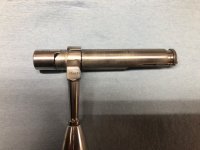Anthony Diorio has brought something new to the three lug rimfire action ignition world. I bought a couple of the new DiOrio actions which will give superior case head penetration, increased firing pin spring life and reduced bolt lift effort in a three lug action. I usually keep my firing travel at .205". Anthony told me to start with .160” firing pin travel. I did so. At the range I caught ten Eley fired cases. The average case head penetration of these cases was .0319" (I expect to move the firing pin travel back to 145-ish to get average case head penetration of around .020-.030”) The bolt lift effort of these new V-3 actions is 30% less than my prior V-3 actions. Part of this reduction in bolt lift effort is due to Anthony’s change in the geometry of the cocking ramps. The other part is the reduction in spring compression length of .060” (.205-.145=60) The spring itself has had several treatments to improve its life. Obviously spring life will not be certain for several years but we should be pleased by the spring life. There have some posts on the internet wherein a speaker said that Anthony’s approach would not work. As my Dad used to say ”One test trumps ten thousand expert opinions. Lawrence Beasley
Lawrence,
Thank you for your post. I am still testing the new mod in a V3. Our observations seem to be the same.
At this point I can certainly say I have seen no downside to the mod. But how long it will hold up will only be learned as time goes by.
With all that has been said about springs lately I know what I'm about to say will be challenged.
But it is my desire to keep this site as helpful and accurate as possible.
Springs, all springs have a cycle life, and they are dying from the time they are put into use. There is no workable application that requires a coil spring to be 100% compressed. All (3) spring makers I have spoken to say 30% or less compression is desired.
A larger spring worked less will last longer than a smaller spring worked harder. From a mechanical point of view, it is obvious the 40X SAP type actions with their larger springs should and do last longer in their working environment than PAS springs in a similar environment.
Our application of a firing pin spring, (coil springs) is different from most coil spring applications. Our firing pin springs suffer a shock every time the trigger is pulled. Most coil springs simply work up and down with a load but without the shock. This shock works to kill our springs at a different rate than a trapped spring simply being cycled. And of course, we don't have a heat issue.
Understanding this is critical to understanding why Di Orio has spent so much time to make the working environment as friendly as possible for a properly designed firing pin spring.
There was a time not long ago one could set up the ignition for a Turbo or Turbo clone with a Pepper spring and it would fire the chisel shaped firing pin for a good long time before failure. Most shooter could get years out of them. My formula was to change the spring when it got shorter than 2 inches in length. Seemed to work for me.
That changed when the crescent shaped pin became popular. If a chisel is as good, or better, than a crescent is another argument all together not for this discussion.
For quite a while now I've been able to set up Turbo ignition with a crescent pin and have it work well. When I say well, I don't just mean fire the round with consistent ignition, I also mean have an acceptable bolt lift.
But I also understand this is not a one and done situation. If the action is worked enough it will change over time. I shoot nearly every day my decay rate may differ from yours.
I believe there is a sweet spot and I want to stay in that sweet spot, especially when I compete. I want to know when to expect failure to occur so I can get out ahead of it.
I will continue to shoot the mod until it starts to fail. Who knows, it may out last me and that would be a good thing, just not from my perspective.
Many don't believe in penetration test. But that may be the first-place potential failure shows up. Oh yes, it also shows up on the target but how many matches will one lose before they properly diagnose the problem?
I realize this is a small crumb. Maybe not worth the time and effort. But I am very happy that Anthony Di Orio has taken the time to address this issue. Who knows, it may be bigger than we think!
TKH



